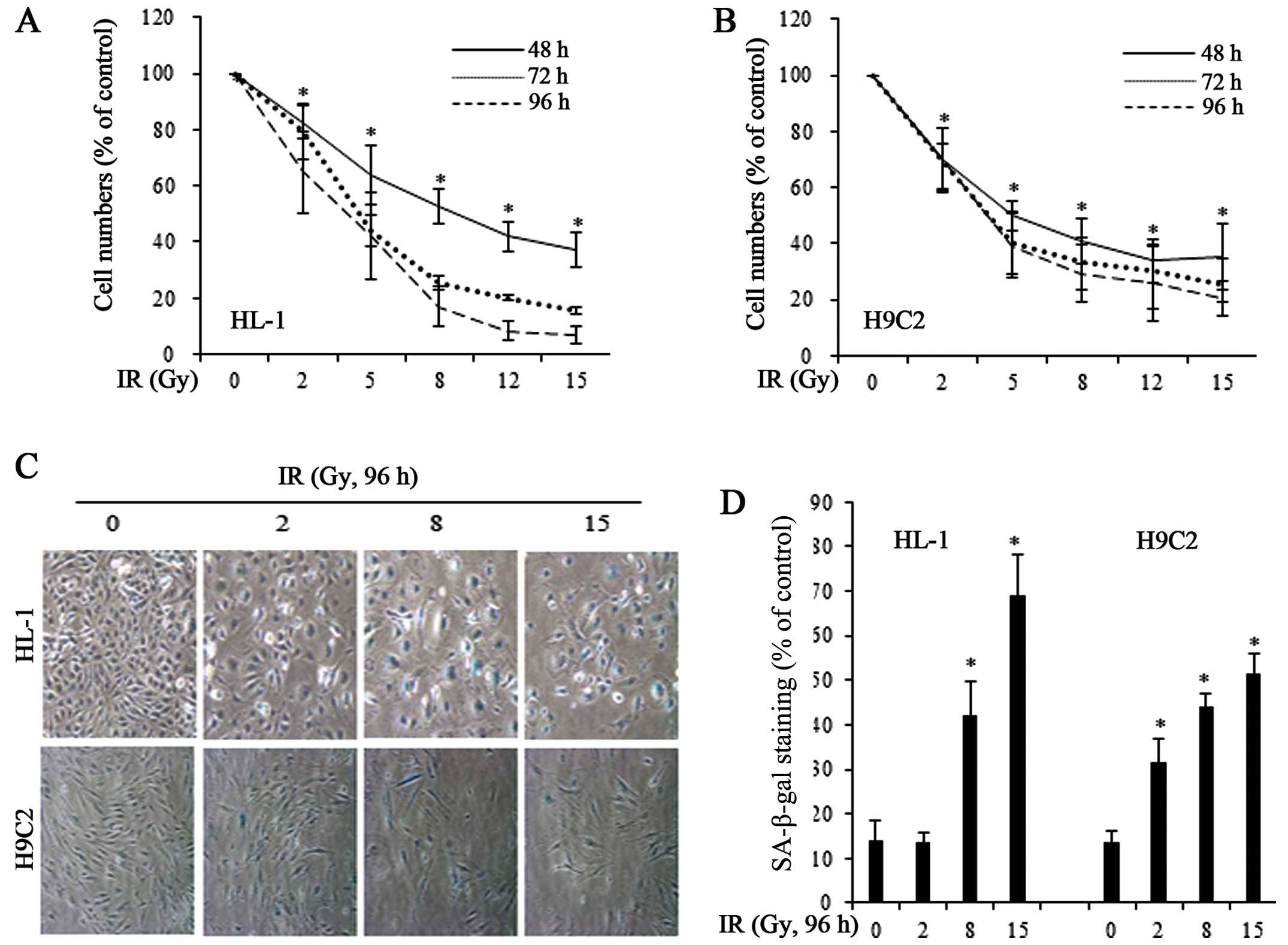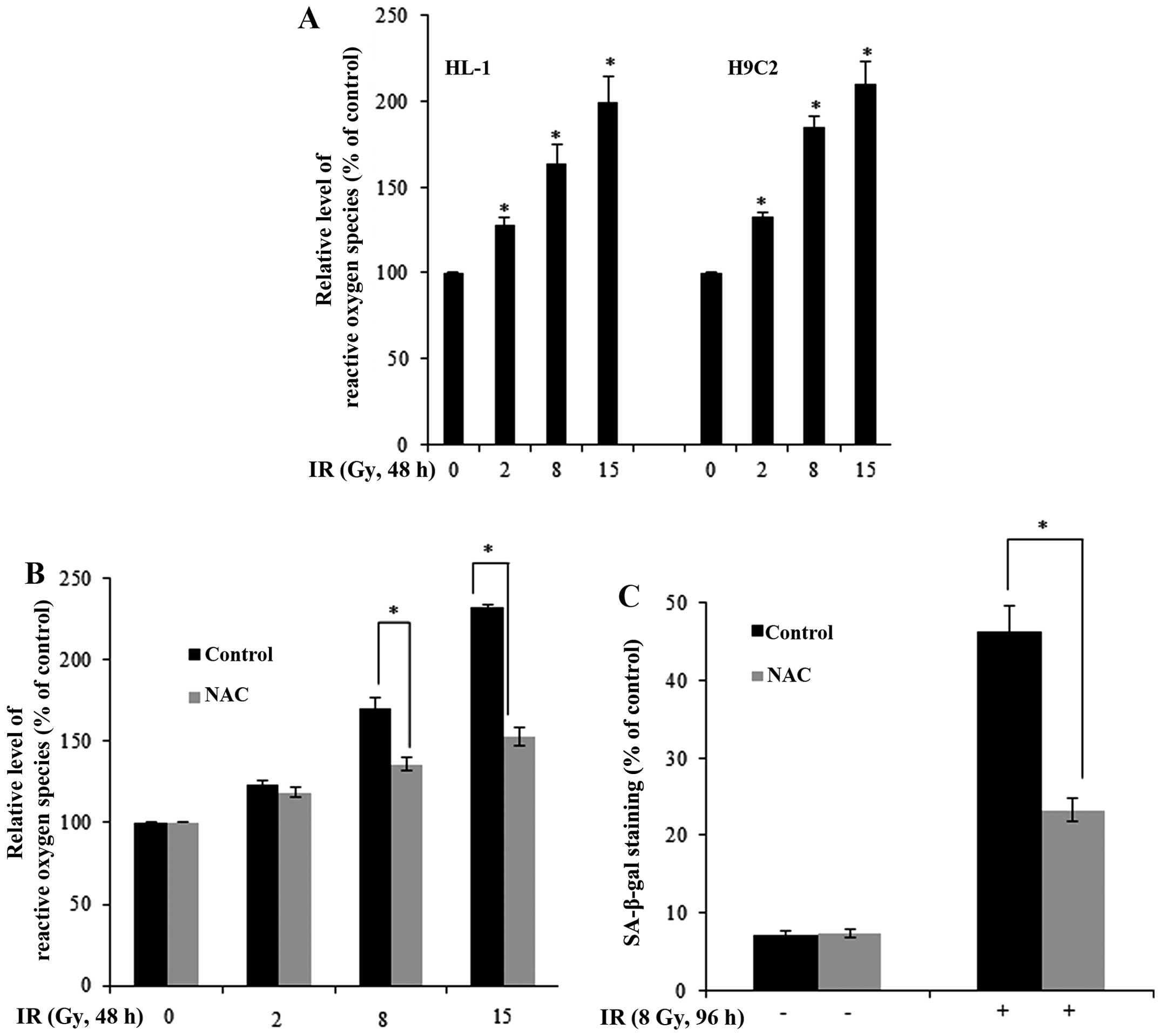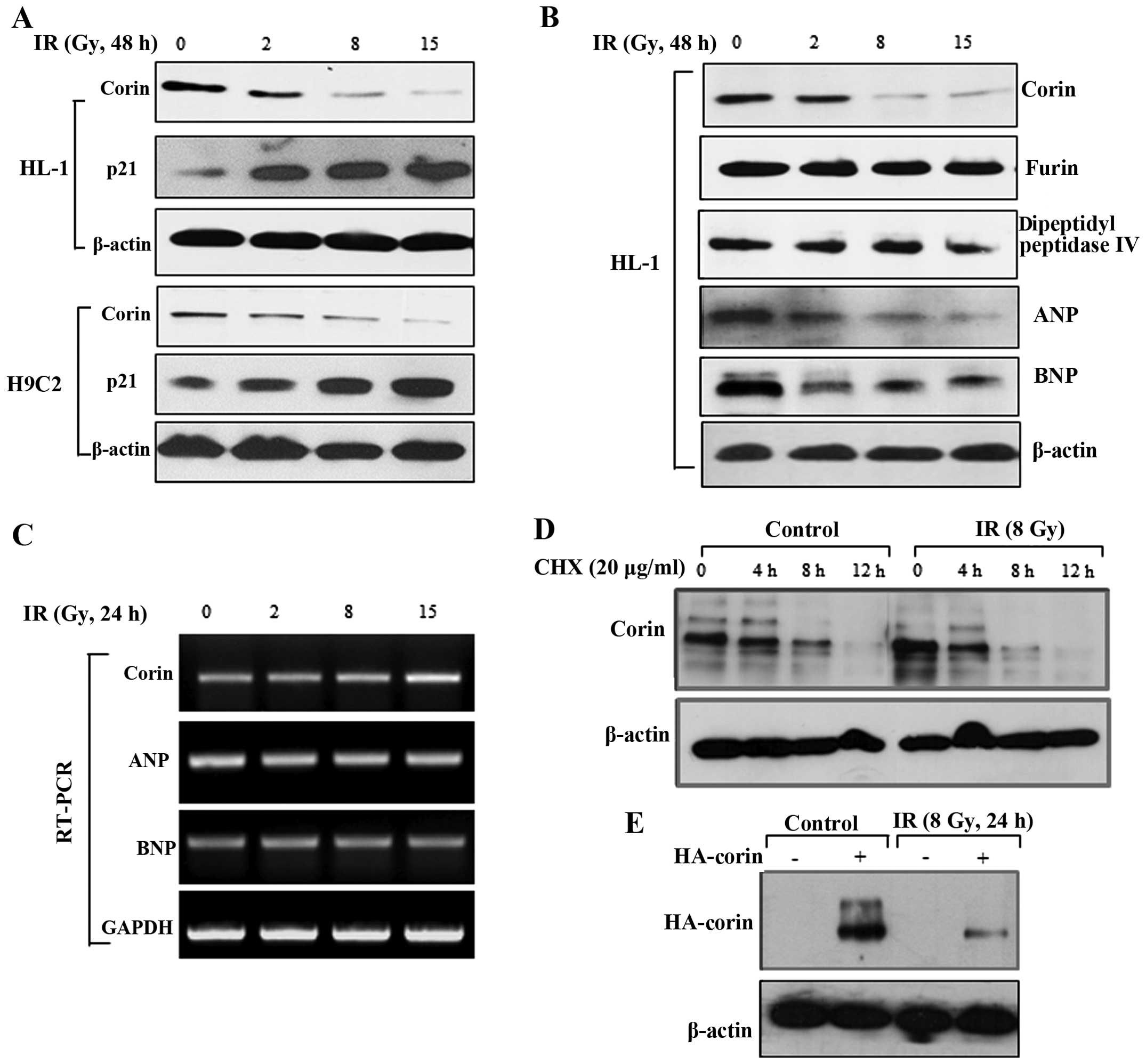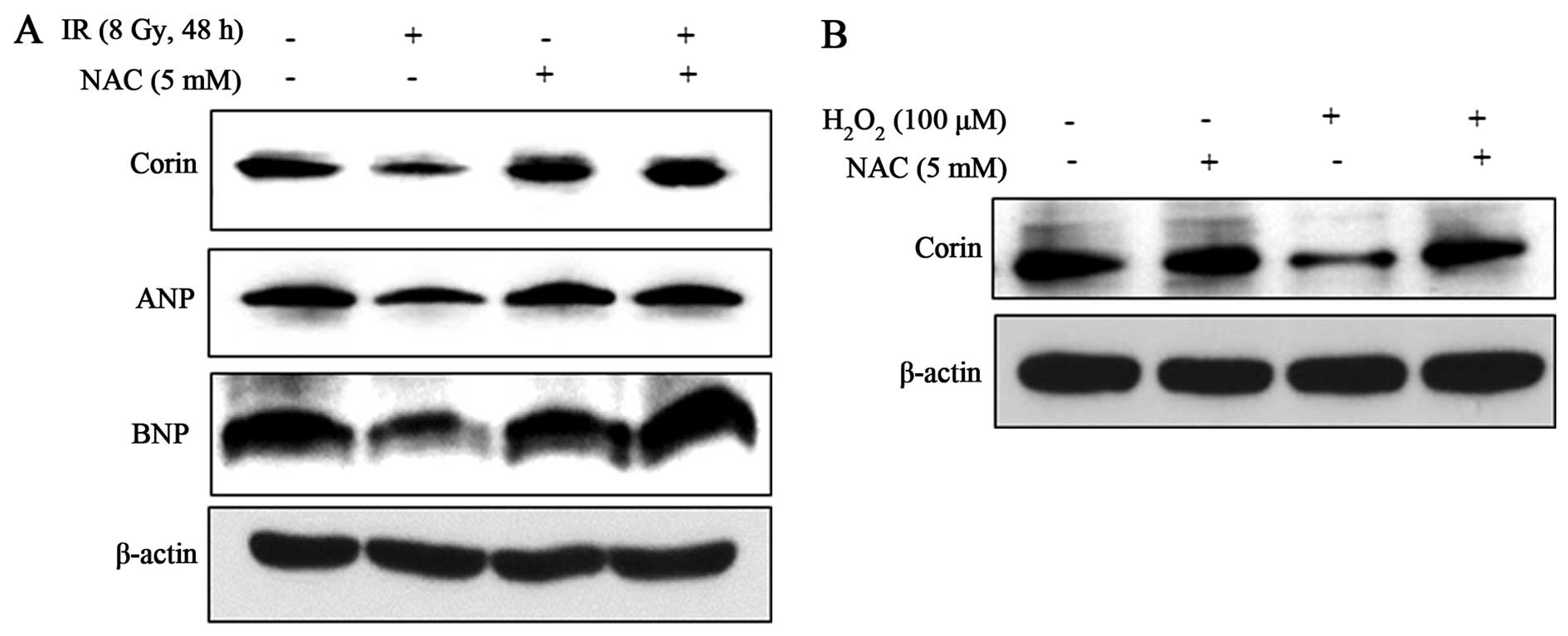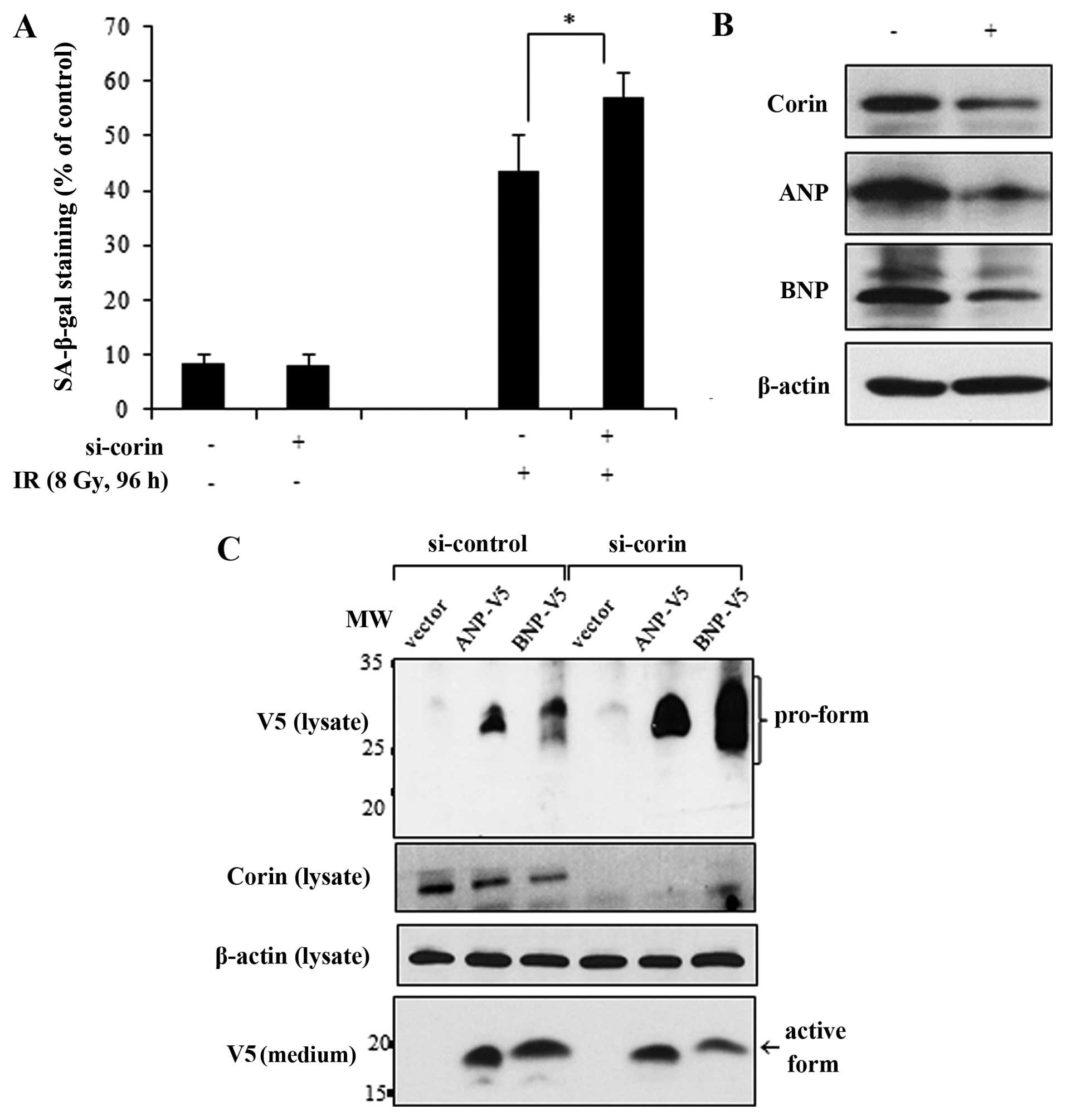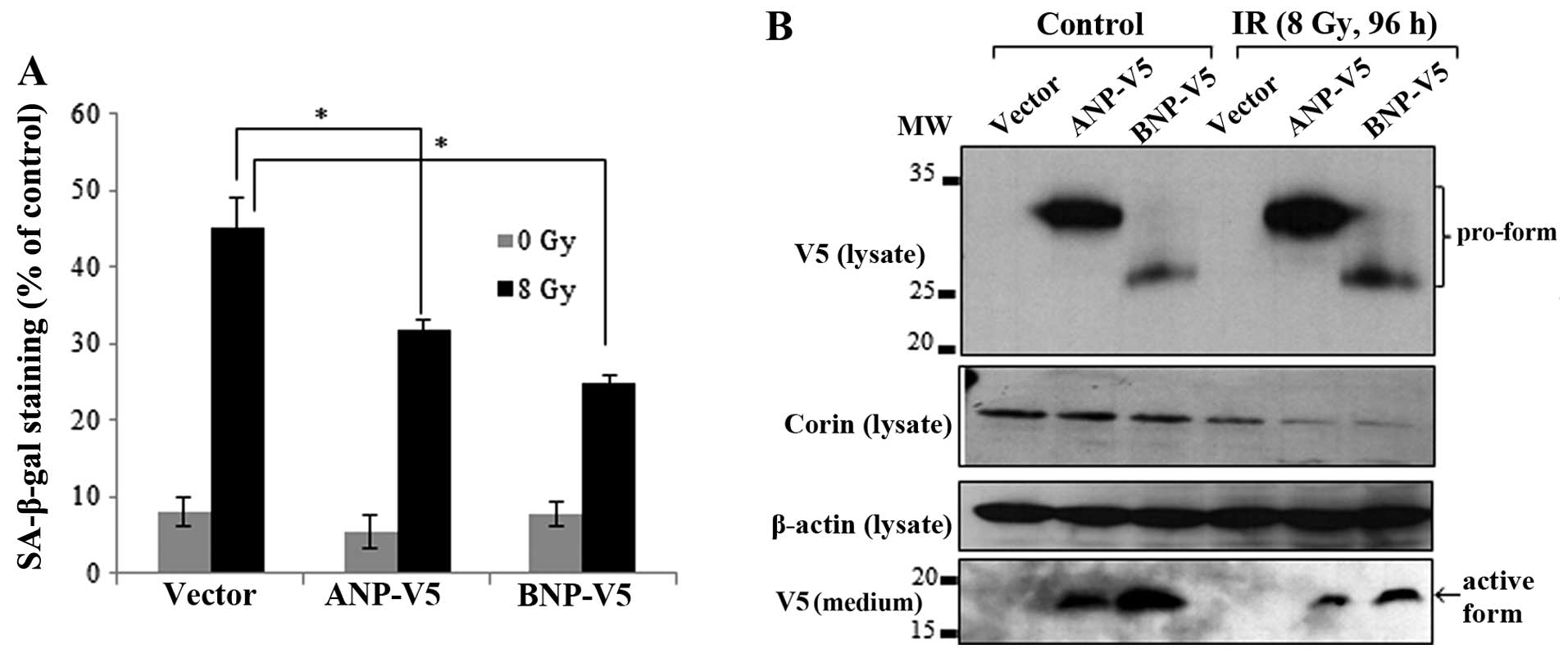Involvement of corin downregulation in ionizing radiation-induced senescence of myocardial cells
- Authors:
- Published online on: December 24, 2014 https://doi.org/10.3892/ijmm.2014.2048
- Pages: 731-738
Abstract
Introduction
Late side-effects of anticancer treatment, such as recurrence, secondary cancer and normal tissue injury from radio- and chemotherapy, are clinical issues faced by cancer survivors. Radiation-induced heart disease (RIHD) is a frequent and serious adverse effect of cancer therapy, affecting the survival and quality of life of patients (1). RIHD may occur among patients with breast cancer and Hodgkin’s lymphoma, as well as in pediatric cancers, as in these patients, irradiation fields can encompass all or part of the heart (2). Some cancer patients treated with ionizing radiation (IR) have been shown to exhibit increased cardiovascular morbidity several years following the administration of radiotherapy (1,2). The cardiovascular complications of radiotherapy include atherosclerosis, myocardial degeneration and valve dysfunction (3). Although numerous studies performed over the years have expanded our understanding of RIHD, the mechanisms responsible for RIHD remain largely unknown. The only available strategies for preventing the development of RIHD involve reducing the doses of radiotherapy to the heart. Although the radiation doses to the heart have decreased in recent years, they still remain high.
Exposure to IR results in the generation of reactive oxygen species (ROS) that cause damage to DNA, proteins and lipids (4). The formation of excessive ROS has been implicated in the aging process and the pathogenesis of cardiovascular diseases (5). Cellular senescence is a physiological process of biological aging through which cells lose their ability to divide and proliferate and contributes to various physiological and pathological processes of aging. Senescence is induced in response to various factors, including IR, that encompasses irreversible growth arrest, normal tissue repair and tumor suppression (6). Whereas replicative senescence has been shown to be associated with telomere shortening after repeated cell division, IR-induced premature senescence occurs in response to DNA damage and occurs independently of telomere dysfunction (7).
Natriuretic peptides are polypeptide hormones that are secreted by the myocardium. These proteins act as powerful regulators of blood pressure and body fluid homeostasis. In addition to their endocrine functions, natriuretic peptides exert autocrine activity that inhibits abnormal cardiac hypertrophy (8). Corin has been identified as a cardiac protease that targets natriuretic peptides, proteolytically cleaving pro-atrial natriuretic peptide (ANP) and pro-brain natriuretic peptide (BNP) to produce the corresponding active hormone forms (9,10). The physiological significance of the function of corin has been demonstrated in studies using experimental animal models, where the disruption of the corin gene has been shown to cause hypertension and cardiac hypertrophy (11). Moreover, in patients with heart failure, corin variants have been demonstrated to be related to poor natriuretic peptide processing and overall clinical outcomes (12). These data suggest that a corin-deficient status may be a major contributor to the onset of cardiovascular diseases and raises the possibility that the pathophysiological function of corin is relevant in the context of radiation-induced cardiac tissue injury.
Although heart muscles have been reported to be resistant to IR, analyses of RIHD have revealed an associated dysfunction of cardiomyocytes (13). To the best of our knowledge, there is no study available to date on the association between RIHD and the IR-induced cellular senescence of cardiomyocytes. Thus, in the current study, we focused on the involvement of cellular senescence and possible alterations in corin expression levels in the development of RIHD. We found that exposure to radiation induced ROS-mediated cellular senescence in HL-1 and H9C2 myocardial cells. Notably, corin expression was significantly decreased by the IR-induced production of ROS in these cells through post-translational regulation. Importantly, the knockdown of corin by RNA interference enhanced the IR-induced senescence. On the contrary, the overexpression of ANP and BNP reversed the IR-induced senescence. Therefore, these data suggest that defects in corin function and the reduction of the natriuretic peptide level in response to IR may contribute to RIHD through the enhancement of cellular senescence.
Materials and methods
Materials
N-acetylcysteine (NAC), cycloheximide and hydrogen peroxide used in this study were obtained from Sigma-Aldrich (St. Louis, MO, USA). The senescence staining kit (ab65351) and antibodies against corin (ab125254) were purchased from Abcam (Cambridge, MA, USA). Predesigned small inhibitory RNAs (siRNAs) specific for corin (si-corin; 1341918) and for negative control (si-control, SN-1001) were purchased from Bioneer (Seoul, Republic of Korea). Antibodies against ANP (sc-18811), hemagglutinin (HA, sc-805), furin (sc-20801), dipeptidyl peptidase IV (sc-9153), and β-actin (sc-47778) were from Santa Cruz Biotechnology, Inc. (Santa Cruz, CA, USA). Antibody against BNP (bs-2207R) was purchased from Bioss (Kensington, Australia). V5-tagged expression plasmids of natriuretic peptides (ANP-V5 and BNP-V5) were a gift from Dr Qingyu Wu (Departments of Molecular Cardiology, Nephrology and Hypertension, Lerner Research Institute, Cleveland Clinic, Cleveland, OH, USA). The pcDNA3.1/V5-His-TOPO expression vector (vector) and antibody against V5 (R961-25) were purchased from Life Technologies (Carlsbad, CA, USA). Expression plasmids of Corin (HA-corin, EX-U0424-M6) were from GeneCopoeia, Inc. (Rockville, MD, USA).
Cell culture, radiation exposure, cell counting and transfection
HL-1 cells, a gift from Dr William C. Claycomb (Department of Biochemistry and Molecular Biology, LSU Health Sciences Center, New Orleans, LA, USA), were grown in Claycomb medium. H9C2 cells (ATCC® CRL-1446; ATCC, Manassas, VA, USA) were grown in Dulbecco’s modified Eagle’s medium (DMEM), supplemented with 10% heat-inactivated fetal bovine serum and antibiotics. All cells were maintained at 37°C in a humidified 5% CO2 atmosphere. For γ-irradiation, the cells were exposed to a 137Cs γ-ray source (Atomic Energy of Canada Ltd., Ontario, ON, Canada) at a dose rate of 3.2 Gy/min. Cells were treated with cycloheximide (20 μg/ml) with or without irradiation and were harvested at the indicated time points. Hydrogen peroxide (H2O2) was added to the cell culture medium at a final concentration of 100 μM. The cells were counted using a trypan blue exclusion procedure to identify live cells. The cells were transfected with plasmids or siRNA using Lipofectamine 2000 (Invitrogen, Carlsbad, CA, USA).
Propidium iodide (PI) staining
The trypsinized cells were washed twice with PBS [137 mM NaCl, 2.7 mM KCl, 4.3 mM Na2HPO4 and 1.4 mM KH2PO4 (pH 7.4)] and collected by centrifugation at 200 × g for 10 min. The supernatant was discarded and pelleted cells were carefully suspended in 500 μl PBS. PI was then added to a final concentration of 40 μg/ml and the cells were analyzed on a FACSCanto II flow cytometer (BD Biosciences, San Jose, CA, USA).
Senescence-associated β-galactosidase (SA-β-gal) staining
The cells were stained for SA-β-gal activity as previously described (14). Briefly, the cells were washed in PBS, fixed for 10 min (room temperature) in 3% formaldehyde. The cells were then incubated at 37°C with fresh senescence-associated (SA-β-Gal) staining solution: 1 mg of 5-bromo-4-chloro-3-indolyl P3-D-galactoside (X-Gal) per ml (stock = 20 mg of dimethylformamide per ml)/40 mM citric acid/sodium phosphate, pH 6.0/5 mM potassium ferrocyanide/5 mM potassium ferricyanide/150 mM NaCl/2 mM MgCl2. Staining was evaluated after a 16-h incubation at oven temperature in a CO2-free atmosphere. The percentage of blue cells (200 cells) observed under a light microscope was calculated.
Measurement of ROS generation
The cells were incubated with 10 μM 2′,7′-dichlorodihydrofluorescein diacetate (DCF-DA; Molecular Probes, Eugene, OR, USA) dye for 30 min. The intensity of DCF-DA fluorescence was determined using a FACSCanto II flow cytometer. (BD Biosciences).
Reverse transcription-polymerase chain reaction (RT-PCR)
Total RNA was extracted and reverse transcribed using Omniscript transcriptase (Qiagen, Hilden, Germany). PCR amplifications were performed using the following primer pairs: corin, 5′-ACC TCT CCT GCA GAG TCC CT-3′ (sense) and 5′-ATG TTC CCA CAA AGG ACA GC-3′ (antisense); ANP, 5′-GGG GGT AGG ATT GAC AGG ATT-3′ (sense) and 5′-CGT GAT AGA TGA AGG CAG GA-3′ (antisense); BNP, 5′-GCC AGT CTC CAG AGC AAT TC-3′ (sense) and 5′-AAG AGA CCC AGG CAG AGT CA-3′ (antisense); GAPDH, 5′-TGC TGA GTA TGT CGT GGA GTC TA-3′ (sense) and 5′-AGT GGG AGT TGC TGT TGA AGT CG-3′ (antisense). The PCR thermocycling conditions were as follows: 95°C for 5 min followed by 30 cycles of 94°C for 45 sec, 60°C for 2 min and 72°C for 2 min.
Immunoblot analysis
Protein samples were prepared by extracting the cells using lysis buffer (50 mM Tris-HCl pH 7.4, 1% NP-40, 0.25% sodium deoxycholate, 150 mM NaCl, 1 mM EDTA, 1 mM PMSF, 1 mM sodium orthovanadate, 1 mM NaF, 1 μg/ml aprotinin, 1 μg/ml leupeptin and 1 μg/ml pepstatin). Proteins were resolved by sodium dodecyl sulfate-polyacrylamide gel electrophoresis and then transferred onto a nitrocellulose membrane. The membrane was incubated with the primary antibody at 4°C overnight and then with the appropriate peroxidase-conjugated secondary antibody for 1 h at room temperature. Immunoreactive proteins were visualized using enhanced chemiluminescence reagents.
Statistical analysis
All data are expressed as the means ± standard deviation (SD), and the mean values were obtained from at least 3 independent experiments. Statistical significance between 2 groups was determined using a Wilcoxon signed-rank test; a value of P<0.05 was considered to indicate a statistically significant difference. All statistical analyses were performed using IBM SPSS Statistical software version 20.0 (SPSS, Inc., Chicago, IL, USA).
Results
IR induces cellular senescence in HL-1 and H9C2 myocardial cells
It is well accepted that cellular senescence occurs in response to IR (6,7,15). Thus, it is reasonable to investigate whether the exposure of myocardial cells to radiation results in a senescent phenotype that may be involved in myocardial dysfunction. In this study, before examining the effects of IR on myocardial cell senescence, we examined whether IR induces myocardial cell death through an apoptotic mechanism. FACS analysis of PI-stained cells showed that a 96-h exposure to IR at doses of 8 and 15 Gy induced <10 and 20% apoptosis, respectively (data not shown). Instead of inducing cell death, IR significantly decreased the number of HL-1 and H9C2 cells compared with the untreated control cells, an effect that was dose-dependent (Fig. 1A and B). To determine whether the growth-inhibitory effects of IR were due to cellular senescence, we exposed the HL-1 and H9C2 cells to IR and stained for SA-β-gal, a marker of senescent cells (Fig. 1C). We found that 8 and 15 Gy of IR significantly increased the number of SA-β-gal-positive, senescent cells in both cell lines (Fig. 1D).
IR-induced ROS production causes senescence of myocardial cells
To elucidate the mechanisms responsible for IR-induced cellular senescence, we investigated the role of ROS generation, which is generally considered a consequence of radiation exposure and a cause of cellular senescence (16,17). Using the fluorescent reactive oxygen probe, DCF-DA, as an indicator, we found that IR increased the generation of ROS in the HL-1 and H9C2 cells (Fig. 2A). Pre-treatment with NAC, a scavenger of ROS, blocked the IR-induced generation of ROS in HL-1 cells (Fig. 2B). Notably, NAC significantly inhibited the IR-induced cellular senescence in the IR-exposed HL-1 cells (as shown by reduced SA-β-gal staining; Fig. 2C), indicating that ROS is a mediator of IR-induced cellular senescence in myocardial cells.
Corin expression levels are decreased following IR-induced ROS generation in myocardial cells
As previously demonstrated, a corin-deficient state is closely associated with heart failure (11). However, the question of whether the function of corin is critically involved in the process of RIHD has not yet been answered. Therefore, in the present study, we aimed to examine whether IR affects the activity of corin, initially examining the protein levels of corin following the exposure of HL-1 and H9C2 myocardial cells to IR. We found that the corin expression levels were significantly decreased following exposure of the HL-1 and H9C2 cells to IR (8 and 15 Gy) (Fig. 3A). In immunoblot analysis, the protein levels of furin and dipeptidyl peptidase IV, which are also proteases for natriuretic peptides, were not significantly altered by exposure to radiation in the HL-1 cells, indicating that the effect of IR was selective for corin (Fig. 3B). Likewise, irradiation for 48 h resulted in a significant reduction in ANP and BNP in HL-1 cells (Fig. 3B). The requirement of the cyclin-dependent kinase inhibitor, p21, in cellular senescence was confirmed by the upregulation of this protein following irradiation (Fig. 3A). To investigate whether the IR-induced decrease in corin protein expression is caused by the inhibition of transcription, we determined corin mRNA levels by RT-PCR. The corin mRNA levels were not altered in the cells exposed to IR; the ANP and BNP mRNA levels were also unaltered in these cells (Fig. 3C). Therefore, the decrease in the protein levels of corin, ANP and BNP induced by IR likely reflects post-translational regulation.
To determine the effect of IR on corin protein stability, we measured protein degradation in the HL-1 cells treated with the protein synthesis inhibitor, cycloheximide. Treatment with cycloheximide decreased corin stability in the IR-exposed cells when compared with the control cells, suggesting that corin stability was decreased by IR (Fig. 3D). We also transiently transfected the HL-1 cells with an HA-tagged corin construct and then exposed these cells to IR. The high of corin expression levels were decreased following exposure to IR (Fig. 3E). These observations suggest that IR affects corin protein stability in myocardial cells. Importantly, the decrease in corin, ANP and BNP protein levels in the IR (8 Gy)-exposed HL-1 cells was significantly attenuated by NAC (Fig. 4A), indicating that IR exerts its effects by promoting the generation of ROS to downregulate these proteins. We confirmed the positive effects of the IR-induced generation of ROS on the reduction of corin protein expression by exposure of the cells to exogenous hydrogen peroxide (100 μM), which resulted in a decrease in corin levels (Fig. 4B). These results suggest that IR-induced ROS is associated with the decrease in corin expression levels in HL-1 cells.
A corin-deficient status enhances the IR-induced senescence of myocardial cells
Given that corin may positively regulate cardiac function through the activation of ANP and BNP, we examined whether the IR-induced decrease in corin expression levels is critically involved in the radiation-induced senescence of myocardial cells. To accomplish this, we transfected the HL-1 cells with si-corin and then exposed them to IR. Compared with the effects of IR in the si-control-transfected cells, the IR-induced cellular senescence was enhanced in the corin-deficient cells (Fig. 5A). The knockdown of corin and the subsequent reduction of ANP and BNP expression levels were confirmed by immunoblot analysis (Fig. 5B). ANP and BNP are synthesized in cardiomyocytes as propeptides and must be cleaved by corin to be secreted (9,10). If the pro-form of natriuretic peptides is not cleaved by corin, it remains in an inactive state. Therefore, to confirm the relevance of corin activity in the proteolytic processing of natriuretic peptides in myocardial cells, we overexpressed V5-tagged ANP and BNP in the si-corin-transfected HL-1 cells and determined the cleavage and release of ANP and BNP into the culture medium. The pro-form of each natriuretic peptide with a C-terminal V5 tag was detected in the cell lysates by immunoblot analysis, and the active forms of ANP and BNP were detected in the medium as 25–35 and 12–17 kDa bands, respectively. However, in the corin-deficient HL-1 cells, the protein levels of pro-ANP and pro-BNP, which were not completely cleaved, were increased in the cell lysates. Conversely, there was a decrease in the amount of active ANP and BNP forms in the culture medium (Fig. 5C). Collectively, these results indicate that the IR-induced inhibition of corin and the subsequent reduction in natriuretic peptides are critically involved in the cellular senescence response to IR in myocardial cells.
Overexpression of natriuretic peptides reverses the IR-induced senescence of myocardial cells
If IR-induced senescence is indeed caused by the inhibition of corin and a subsequent decrease in ANP and BNP levels, the overexpression of these peptides should rescue cells from IR-induced senescence. In order to confirm this hypothesis, the HL-1 cells were transfected with V5-tagged ANP and BNP. The overexpression of ANP and BNP partially reversed the IR-induced senescence of HL-1 cells (Fig. 6A). The corin expression levels in the cell lysates and the expression of V5-tagged ANP and BNP proteins in the cell lysates and culture medium were confirmed by immunoblot analysis. Although the levels of the pro-forms of ANP and BNP were increased in the irradiated cell lysates, the active forms of ANP and BNP in the culture medium were reduced (Fig. 6B).
Discussion
Despite advances in radiotherapy safety, RIHD may occur among patients with breast cancer and Hodgkin’s lymphoma, as well as in childhood cancers and in other types of cancer-following treatment with radiation where the heart is also exposed (3). Although RIHD is becoming a great concern for cancer patients and clinicians, there are only a few methods available to prevent or reverse RIHD, and the underlying biological mechanisms remain poorly understood. Importantly, in vivo studies have suggested that myocardial degeneration and fibrosis are involved in the pathogenesis of RIHD (13). Sridharan et al (18) demonstrated that a cardiac inflammatory response is a major reaction of the heart to irradiation. Another important finding is that IR causes alterations in cardiac mitochondria, resulting in oxidative stress that may ultimately lead to dysfunction of the myocardium (19). Given that oxidative stress has been suggested to be a major contributor to IR-induced heart damage, researchers have investigated the effects of antioxidants on radiation injury as part of an effort to establish potential therapeutic agents against RIHD (20). However, the underlying mechanism(s) remain unknown, and therapeutic strategies for the treatment or prevention of RIHD remain in the pre-clinical stage (2). Thus, investigations into the mechanisms of RIHD, as well as the identification of novel therapeutic targets and the development of effective strategies for the prevention of RIHD are essential.
To investigate the molecular mechanisms responsible for the development of RIHD, we examined the effects of IR in myocardial cells. We found that IR induced ROS-mediated cellular senescence in myocardial cells (Figs. 1 and 2). This increase in the senescence of IR-exposed myocardial cells was associated with a decrease in corin expressino levels and the inactivation of natriuretic peptides (Figs. 3 and 4). Importantly, the knockdown of corin enhanced the IR-induced senescence of myocardial cells (Fig. 5). By contrast, the overexpression of ANP and BNP reversed this phenomenon (Fig. 6). Overall, these observations suggest that the senescence of the myocardium and its progressive degeneration, caused by a decrease in corin expression and its substrates, may be involved in the pathogenesis of RIHD.
Corin is known as an essential protease for processing pro-natriuretic peptides in cardiomyocytes and thereby regulates multiple physiological functions in the cardiovascular system (9). The fact that corin has been placed center-stage in the study of the progression of heart diseases highlights the importance of exploring the association between corin expression and RIHD severity and/or phenotype in cancer patients receiving radiotherapy (21). The two most intensively studied substrates of corin, ANP and BNP, are closely linked to compensatory mechanisms in failing hearts (11,21). An elevation in BNP levels has been suggested to reflect an attempt to correct a serious dysfunction of the heart (22). Significantly, a synthetic natriuretic peptide analogue has been used clinically in patients with heart failure (12,22). However, the potential use of natriuretic peptide analogues in cancer patients receiving radiotherapy is underappreciated, and may represent a promising therapeutic strategy in RIHD.
Importantly, it has been shown that corin expression is downregulated during heart failure (11,21). Soluble corin is detected in human plasma, and its levels are decreased in patients with heart failure (21). In addition, high levels of the pro-form of plasma natriuretic peptides have also been found in cardiovascular disease patients (23). In agreement with these studies, our results demonstrated that corin and the active forms of natriuretic peptides were decreased in response to IR in myocardial cells. The IR-induced decrease in corin protein expression was accompanied by a decrease in corin protein stability without a change in mRNA levels, suggesting a post-translational mechanism (Fig. 3). Similar to the decrease observed in corin protein stability, both the levels of ANP and BNP were also significantly reduced by IR (Fig. 3B and C). The mechanisms behind this concomitant decrease in proteases and their substrates remain unresolved, as it is questionable whether the loss of corin function is the reason underlying the decrease in ANP and BNP levels. Further studies are required to clarify the association between the reduction in corin protein levels and the decrease in the active forms of natriuretic peptides in irradiated myocardial cells.
Since corin is generally considered the master protease of natriuretic peptides, we overexpressed V5-tagged ANP and BNP in HL-1 cells in conjunction with si-corin transfection or IR exposure to evaluate the corin-mediated processing of ANP and BNP. Importantly, the knockdown of corin or exposure to IR increased the pro-form of natriuretic peptides and subsequently decreased the active forms of ANP and BNP (Figs. 5C and 6B). These results suggest that a lesser degree of active natriuretic peptides cleavage ensues as a consequence of the IR-induced decrease in corin expression levels.
However, the decrease in the active forms of natriuretic peptides in the culture medium as a result of the knockdown of corin or the IR-induced decrease in corin expression levels was only partial (Figs. 5C and 6B), suggesting that the pro-forms of natriuretic peptides may be processed by other proteases, such as furin and dipeptidyl peptidase IV, which are expressed in HL-1 cells (11,24). Although the natriuretic peptide processing induced by IR was incomplete (Fig. 6B), the overexpression of ANP and BNP reversed the IR-induced senescence of HL-1 cells (Fig. 6A). It remains to be determined whether IR affects the enzymatic activity of multiple proteases, including furin and dipeptidyl peptidase IV in cardiomyocytes.
Future studies on senescence in the myocardium and changes in the expression levels of corin and natriuretic peptides in vivo using experimental animal models of RIHD are required to provide fundamental information on the diagnosis and prognosis of RIHD, as well as on the therapeutic applications of natriuretic peptide analogues. In view of our findings, corin may be required for appropriate myocardial function during or following exposure to IR. Additionally, the modulation of corin activity and treatment with natriuretic peptides analogues, which are valuable for further understanding the myocardial responses to IR, may become possible therapeutic strategies for RIHD.
Acknowledgments
We would like to thank Dr Willliam C. Claycomb (Department of Biochemistry and Molecular Biology, LSU Health Sciences Center, New Orleans, LA, United States of America) and Dr Qingyu Wu (Departments of Molecular Cardiology, Nephrology and Hypertension, Lerner Research Institute, Cleveland Clinic, Cleveland, OH, USA) for providing the HL-1 cells and the natriuretic peptide expression plasmids. This study was supported by the Nuclear Research and Development Program through the National Research Foundation of Korea (NRF) (grant no. 2012M2A2A7012483).
References
|
Jaworski C, Mariani JA, Wheeler G and Kaye DM: Cardiac complications of thoracic irradiation. J Am Coll Cardiol. 61:2319–2328. 2013. View Article : Google Scholar : PubMed/NCBI | |
|
Darby SC, Cutter DJ, Boerma M, et al: Radiation-related heart disease: current knowledge and future prospects. Int J Radiat Oncol Biol Phys. 76:656–665. 2010. View Article : Google Scholar : PubMed/NCBI | |
|
Lee PJ and Mallik R: Cardiovascular effects of radiation therapy: practical approach to radiation therapy-induced heart disease. Cardiol Rev. 13:80–86. 2005. View Article : Google Scholar : PubMed/NCBI | |
|
Azzam EI, Jay-Gerin JP and Pain D: Ionizing radiation-induced metabolic oxidative stress and prolonged cell injury. Cancer Lett. 327:48–60. 2012. View Article : Google Scholar | |
|
Tsutsui H, Kinugawa S and Matsushima S: Oxidative stress and heart failure. Am J Physiol Heart Circ Physiol. 301:H2181–H2190. 2011. View Article : Google Scholar : PubMed/NCBI | |
|
Suzuki M and Boothman DA: Stress-induced premature senescence (SIPS) - influence of SIPS on radiotherapy. J Radiat Res. 49:105–112. 2008. View Article : Google Scholar : PubMed/NCBI | |
|
Suzuki K, Mori I, Nakayama Y, Miyakoda M, Kodama S and Watanabe M: Radiation-induced senescence-like growth arrest requires TP53 function but not telomere shortening. Radiat Res. 155:248–253. 2001. View Article : Google Scholar | |
|
Woods RL: Cardioprotective functions of atrial natriuretic peptide and B-type natriuretic peptide: a brief review. Clin Exp Pharmacol Physiol. 31:791–794. 2004. View Article : Google Scholar : PubMed/NCBI | |
|
Ichiki T, Huntley BK, Heublein DM, et al: Corin is present in the normal human heart, kidney, and blood, with pro-B-type natriuretic peptide processing in the circulation. Clin Chem. 57:40–47. 2011. View Article : Google Scholar | |
|
Yan W, Wu F, Morser J and Wu Q: Corin, a transmembrane cardiac serine protease, acts as a pro-atrial natriuretic peptide-converting enzyme. Proc Natl Acad Sci USA. 97:8525–8529. 2000. View Article : Google Scholar : PubMed/NCBI | |
|
Ichiki T, Boerrigter G, Huntley BK, et al: Differential expression of the pro-natriuretic peptide convertases corin and furin in experimental heart failure and atrial fibrosis. Am J Physiol Regul Integr Comp Physiol. 304:R102–R109. 2013. View Article : Google Scholar : | |
|
Dong N, Chen S, Wang W, Zhou Y and Wu Q: Corin in clinical laboratory diagnostics. Clin Chim Acta. 413:378–383. 2012. View Article : Google Scholar | |
|
Stewart FA: Mechanisms and dose-response relationships for radiation-induced cardiovascular disease. Ann ICRP. 41:72–79. 2012. View Article : Google Scholar : PubMed/NCBI | |
|
Debacq-Chainiaux F, Erusalimsky JD, Campisi J and Toussaint O: Protocols to detect senescence-associated beta-galactosidase (SA-betagal) activity, a biomarker of senescent cells in culture and in vivo. Nat Protoc. 4:1798–1806. 2009. View Article : Google Scholar : PubMed/NCBI | |
|
Tapio S: Ionizing radiation effects on cells, organelles and tissues on proteome level. Adv Exp Med Biol. 990:37–48. 2013. View Article : Google Scholar : PubMed/NCBI | |
|
Leach JK, Van Tuyle G, Lin PS, et al: Ionizing radiation-induced, mitochondria-dependent generation of reactive oxygen/nitrogen. Cancer Res. 61:3894–3901. 2001.PubMed/NCBI | |
|
Hong EH, Lee SJ, Kim JS, et al: Ionizing radiation induces cellular senescence of articular chondrocytes via negative regulation of SIRT1 by p38 kinase. J Biol Chem. 285:1283–1295. 2010. View Article : Google Scholar : | |
|
Sridharan V, Tripathi P, Sharma SK, et al: Cardiac inflammation after local irradiation is influenced by the kallikrein-kinin system. Cancer Res. 72:4984–4992. 2012. View Article : Google Scholar : PubMed/NCBI | |
|
Barjaktarovic Z, Shyla A, Azimzadeh O, et al: Ionising radiation induces persistent alterations in the cardiac mitochondrial function of C57BL/6 mice 40 weeks after local heart exposure. Radiother Oncol. 106:404–410. 2013. View Article : Google Scholar : PubMed/NCBI | |
|
Finnberg N, Wambi C, Kennedy AR and El-Deiry WS: The effects of antioxidants on gene expression following gamma-radiation (GR) and proton radiation (PR) in mice in vivo. Cell Cycle. 12:2241–2247. 2013. View Article : Google Scholar : | |
|
Chen S, Sen S, Young D, Wang W, Moravec CS and Wu Q: Protease corin expression and activity in failing hearts. Am J Physiol Heart Circ Physiol. 299:H1687–H1692. 2010. View Article : Google Scholar : PubMed/NCBI | |
|
Maisel AS, Krishnaswamy P, Nowak RM, et al: Rapid measurement of B-type natriuretic peptide in the emergency diagnosis of heart failure. N Engl J Med. 347:161–167. 2002. View Article : Google Scholar : PubMed/NCBI | |
|
D’Errico MP, Grimaldi L, Petruzzelli MF, et al: N-terminal pro-B-type natriuretic peptide plasma levels as a potential biomarker for cardiac damage after radiotherapy in patients with left-sided breast cancer. Int J Radiat Oncol Biol Phys. 82:e239–e246. 2012. View Article : Google Scholar | |
|
Semenov AG, Tamm NN, Seferian KR, et al: Processing of pro-B-type natriuretic peptide: furin and corin as candidate convertases. Clin Chem. 56:1166–1176. 2010. View Article : Google Scholar : PubMed/NCBI |



